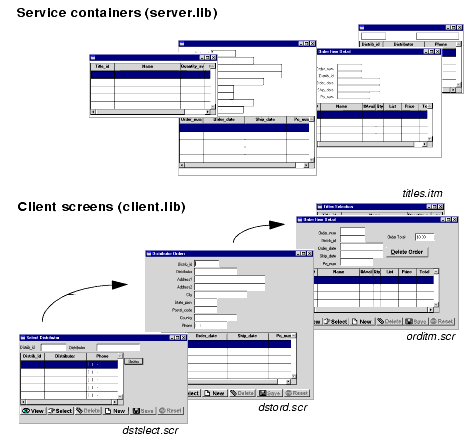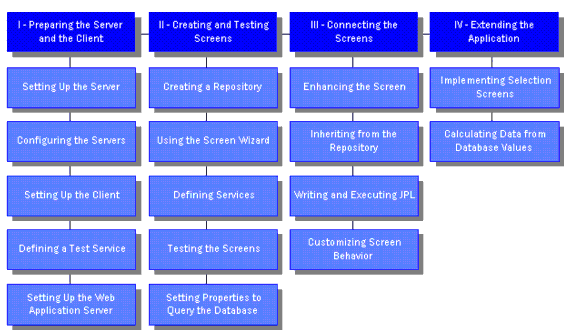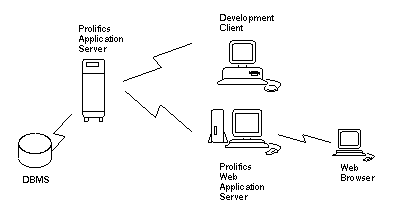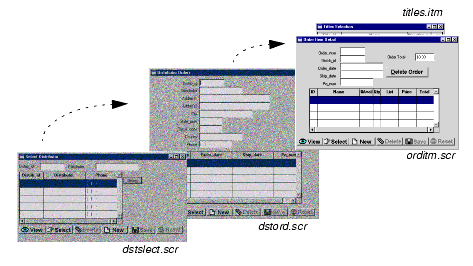




 | Getting Started-JetNet |     |
The tutorial is designed to give you an overview of three-tier application development for JetNet and Oracle Tuxedo applications—providing you with a general methodology for enhanced client/server application development.
Whether you are new to Panther software or are already a user, a novice programmer or an experienced software engineer, you can build this mini-application to learn about Panther's application development process. In addition, you can use the tutorial's examples, principles, code, and concepts as a template for your own applications.
About this Tutorial |  |
You are now ready for the feature presentation—get ready to begin the tutorial!
The tutorial is organized into four modules—preparing the client and the server, creating and testing screens, connecting the screens, and extending the application—plus a wrap-up, designed to be completed in sequence. An introduction precedes each module, describing the basic concepts you'll learn and what you can expect to accomplish as a result of completing the module. Each module includes from one to five lessons—for a total of 16 lessons.
You will start by setting up the three-tier environment. In practice, a project leader would probably set this up for the development team—the intent here is for you to become familiar with the process of setting up a three-tier development environment.
Once you have the environment set up, you can begin building your application—creating three screens that implement some of the functions used to view and update video distributors and their orders.
The tutorial provides you with a JDB database containing distributor and order data. It also includes a tutorial library, which contains the client screens, service components, and JPL modules you'll use in the lessons.

You can click on any of the lessons in the following figure to access that lesson.

Figure 0-1 Lessons in the JetNet Tutorial
Module 1 consists of five lessons that guide you through the process of setting up the Panther software environment to run a three-tier JetNet or Oracle Tuxedo application. In practice, a project leader would probably set this up for the development team—the intent here is for you to become familiar with the process of setting up a three-tier development environment.
In the first four lessons, you start up the application and its servers, start up a client, save screens to their appropriate client and server libraries, define a service in the JIF, and then try out the client screen to test the connection between client and server. In the fifth lesson, you set up a Panther web application server and test the same client screen using a web browser.

On completing this module, you will have a client screen that issues service requests to a Panther application server and to a Panther web application server.
In the process of setting up the environment, you are introduced to the following concepts:
Three types of servers are supported by Panther:
All Panther components, such as screens, menu bars, and so forth, reside in libraries. The three standard libraries, Panther applications depend on a number of environment and/or setup variables. These describe the operating environment—for example, the layout of your system and the terminal you are using. They also point to the Panther software installation and specific setup files, and other files required by the application such as libraries. Setup files can also store variables that control the behavior of a Panther application and how users interact with it—for example, message display, cursor behavior, and numeric format.
client.lib, server.lib, and common.lib, contain objects used by clients, servers, and both, respectively.
rbboot and rbshutdown also provide the ability to quickly start up and shut down a Panther application.
Panther accesses the JIF whenever it needs to determine the requirements and specifications of a service. You create and edit JIF files using the JIF editor.
Module 2 consists of five lessons that start you on the process of building your application—one that will implement the functions used to view and update a list of video distributors and their orders. In these lessons, you:
Module 2—Creating and Testing Screens
Module 3 consists of four lessons that show you how to improve the appearance, capabilities, and flow of your application. In these lessons, you:
Module 3—Connecting the Screens
When you have completed the lessons in this module, you will have a second screen, which you will use to query the database for distributors using either their name or ID, and to invoke the screen you created in Module 2.
In Lesson 13, you add JPL procedures to your screens. These procedures are provided in tutorial.lib, and their contents are described in the lesson. If you have additional questions about the code, you can refer to the comments in the actual JPL procedure, since the comments are not included in the lesson text.
In the process of creating the query screen, you will be introduced to the following concepts:
Module 4 consists of two lessons that guide you through the process of adding a third screen to your application. The screen and its service component, an order entry interface, are created using the screen wizard. It allows the user to add a new order and update existing ones for a selected video distributor.
In the process of developing this portion of the application, you will be introduced to the following concepts:
Module 4—Extending the Application

Hints for Completing the Tutorial |  |
Before You Start |  |
Before you begin the tutorial, you should be aware of the following requirements:
For more information on configuring systems to run the tutorial, refer to Appendix A, "Setting Up the Tutorial."
For More Information... |  |
As you're progressing through the tutorial, you might find that you have questions about a specific area of Panther; or you may just want to learn more about a topic after completing the tutorial. Listed below are places you can look for more information online.



